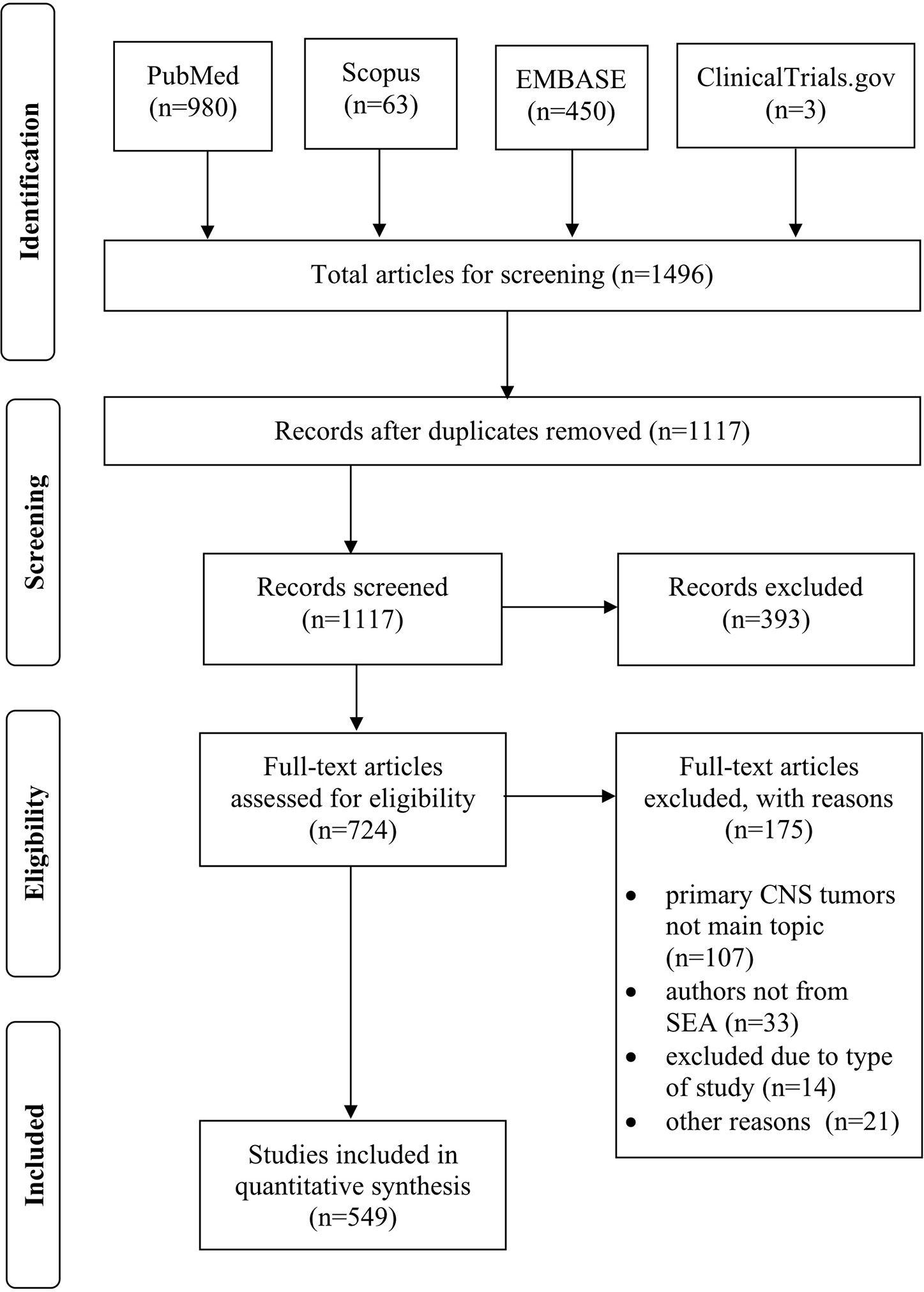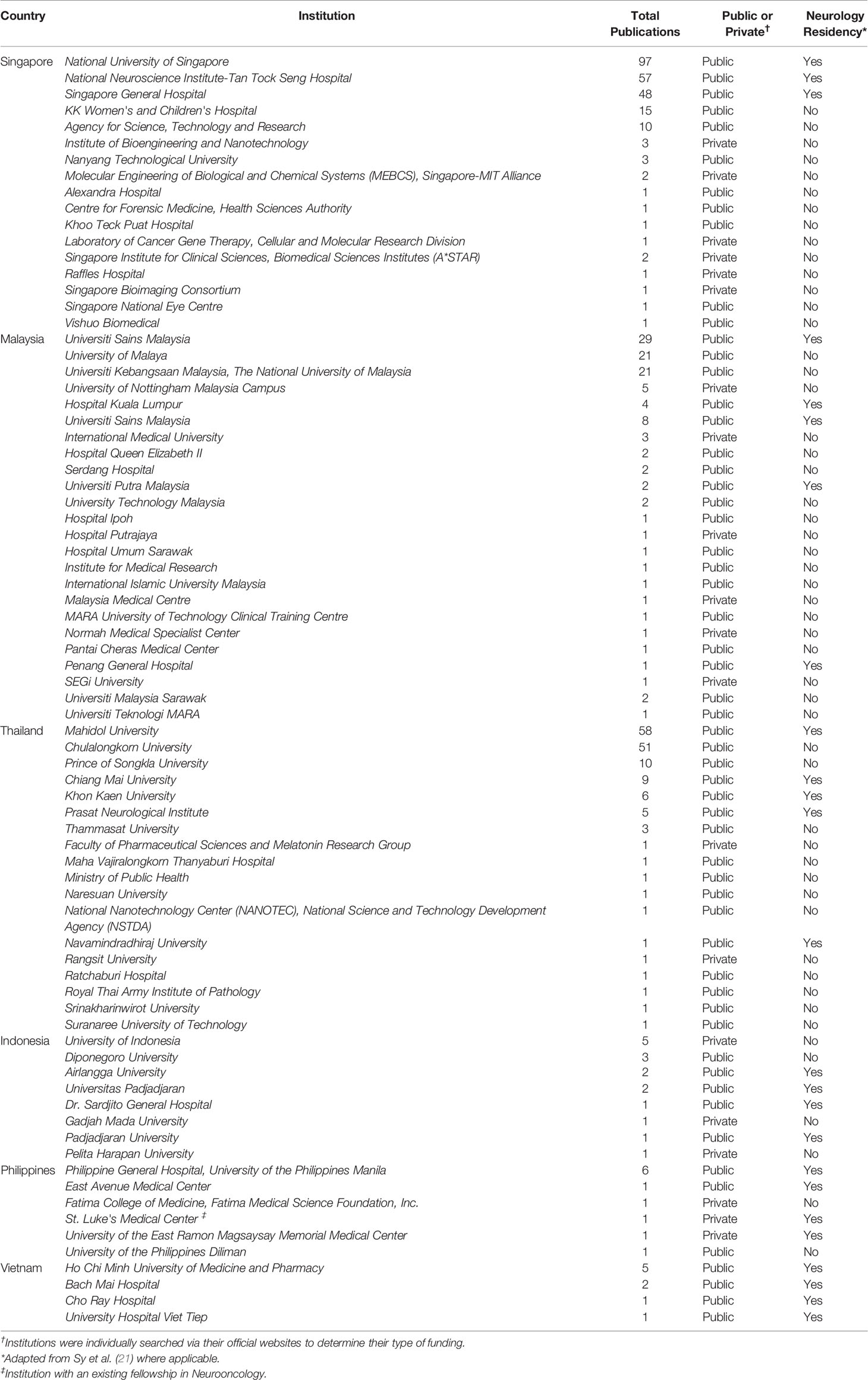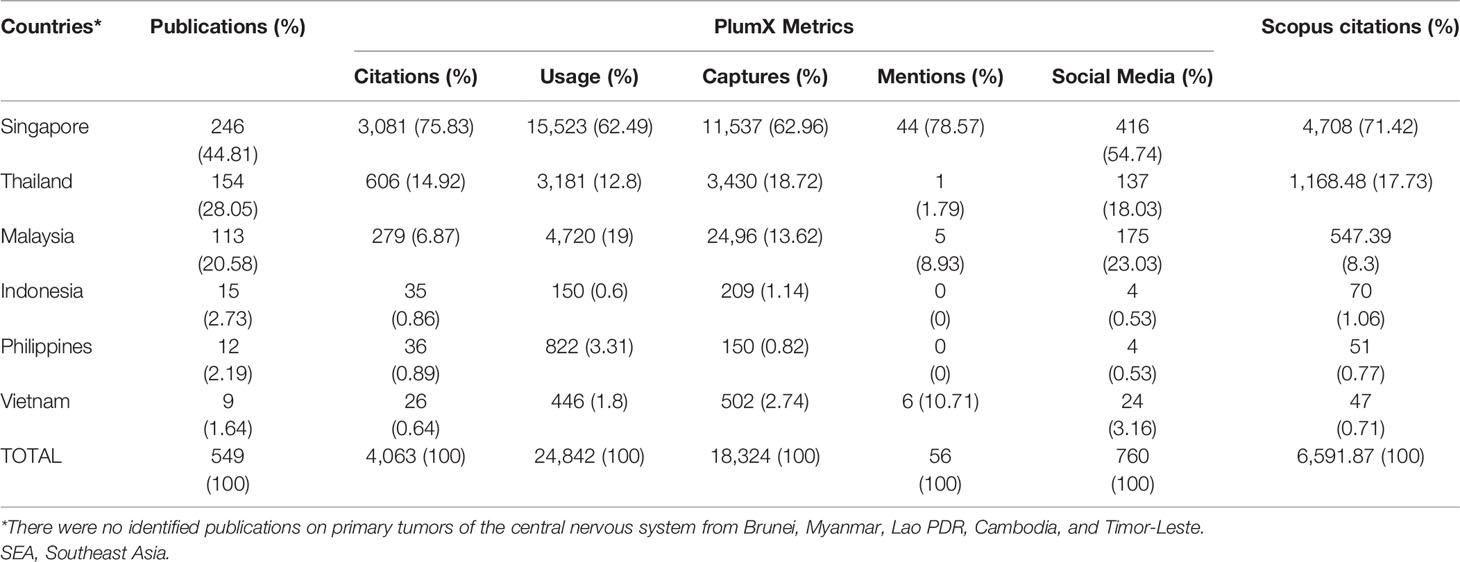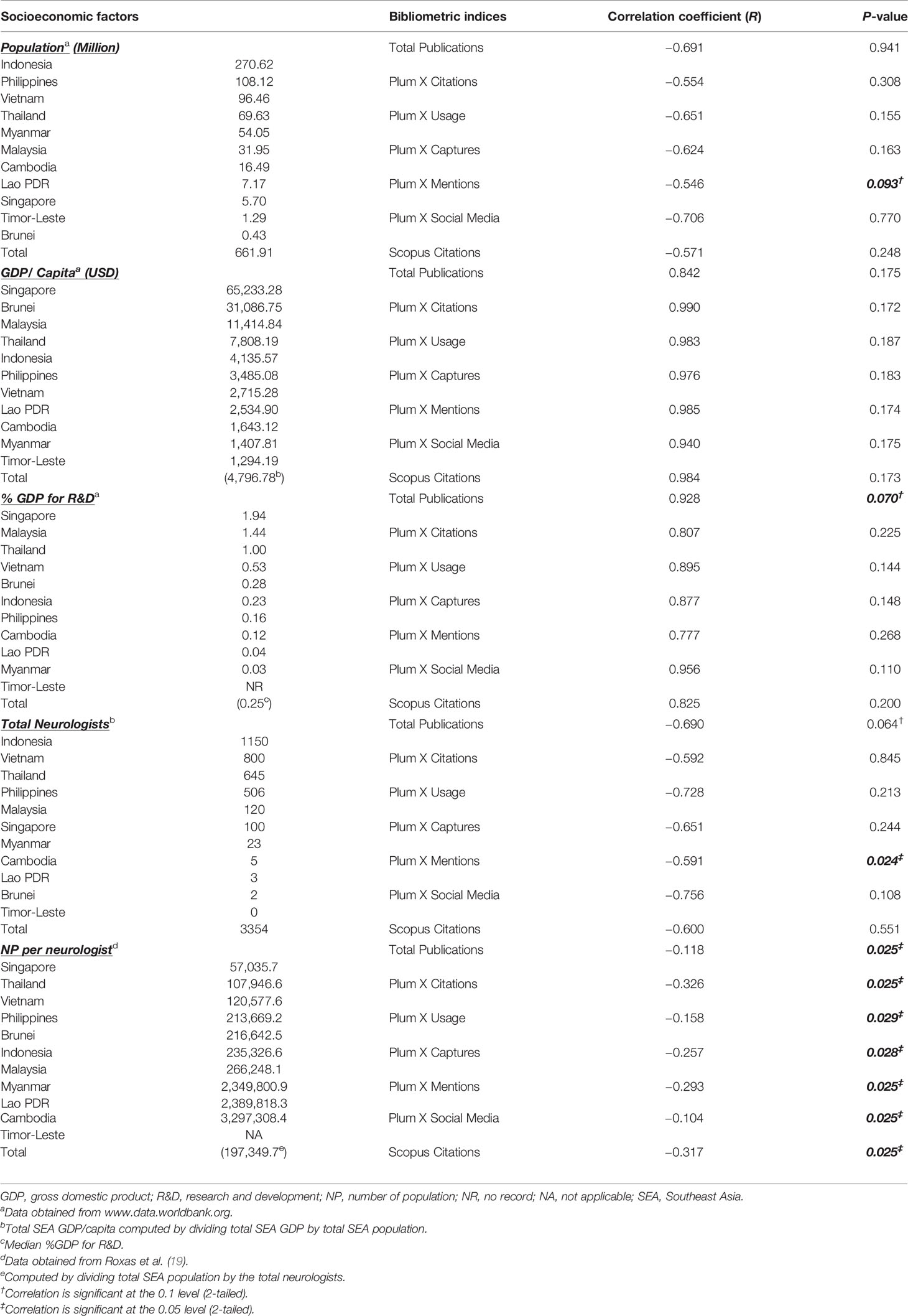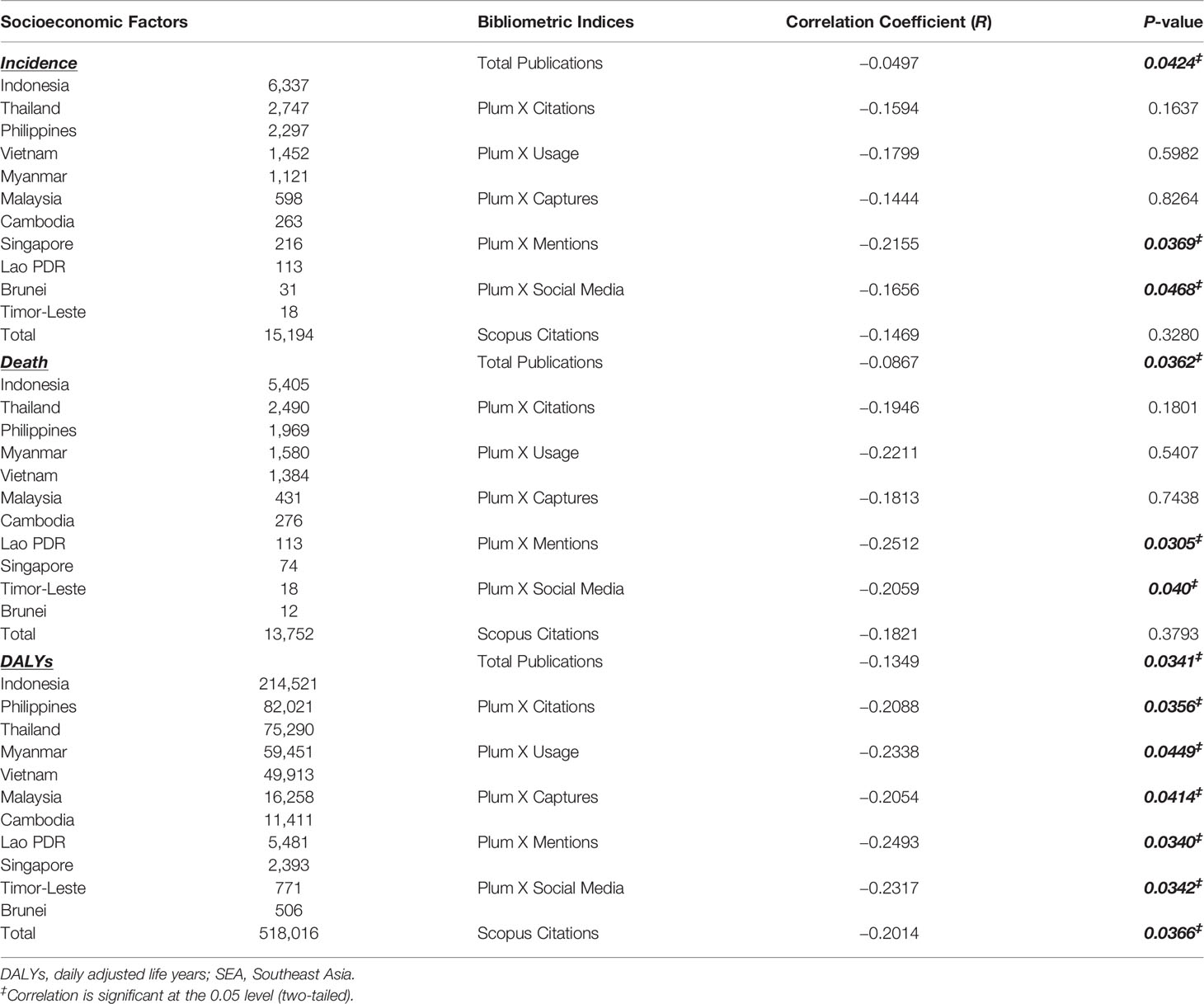- 1Division of Adult Neurology, Department of Neurosciences, College of Medicine and Philippine General Hospital, University of the Philippines Manila, Manila, Philippines
- 2Department of Clinical Epidemiology, College of Medicine, University of the Philippines Manila, Manila, Philippines
- 3Institute for Neurosciences, St. Luke's Medical Center, Quezon City & Global City, Philippines
Background: There is an unmet need to assess research productivity from southeast Asia (SEA) regarding primary central nervous system (CNS) tumors. The country’s economy, landscape of neurology practice, and disease burden are hypothesized to correlate with scientific output. This study aimed to objectively measure the impact of published studies on primary brain tumors in SEA and to assess for correlation with socioeconomic determinants and burden of disease.
Methods: We systematically searched electronic databases for relevant articles from SEA on primary CNS tumor until July 31, 2020. Bibliometric indices were reported and subjected to correlational analysis with population size, gross domestic product (GDP) per capita, percentage (%) GDP for research and development (R&D), total number of neurologists, disease incidence, deaths, and disability-adjusted life years.
Results: A total of 549 articles were included, consisting primarily of case reports (n=187, 34.06%) and discussed gliomas (n=195, 35.52%). Singapore published the most number of the articles (n=246, 44.8%). Statistical analysis showed a positive correlation between %GDP for R&D and total publication. Additionally, negative relationships were noted between burden of disease and total neurologist with most bibliometric indices. However, GDP per capita was not correlated with measures for research productivity.
Conclusion: The low impact of scientific output on primary CNS tumors in SEA does not address the growing epidemiology and burden of this disease. An increase in the GDP growth and financial and manpower investment to R&D may significantly improve research productivity in SEA.
Introduction
The incidence of CNS cancer in developing nations has seen a percentage increase change from as low as 15% to as high as 80% in comparison to data last 2009 that cited highest incidence in developed countries (1–3). At present, the world population is estimated at 7.8 billion with Indonesia, the Philippines, Vietnam, and Thailand included in the top 20 largest countries by population (4). These southeast Asian (SEA) countries are projected to grow by 4.9% in terms of gross domestic product (GDP) by 2024 (5).
The global variability of CNS tumors have been attributed to differences in environmental factors, genetic susceptibility, cultural practices, and resources for accurate diagnosis (6). Multidisciplinary approach including neurologists, neurosurgeons, radiation oncologists, and neuropathologists is the usual practice in treating patients with CNS tumors; however most data on regional practice mostly come from Western countries (7). Most Neuro-oncologists in the United States (US) are neurologists who undergo additional training in Neuro-oncology (8). Neuro-oncology is an emerging neurologic subspecialty wherein Neuro-oncologist provide diagnosis and treatment for patients with brain tumors (8).
It has been shown that accelerating progress in cancer-related research through increasing research and development (R&D) expenditure has the potential to improve the health and quality of life of patients with CNS tumors (9, 10). The clinical impact of a research output can be objectively measured using Alternative Metrics or “almetrics” like PlumX from Plum Analytics. These incorporates traditional bibliometrics like citations alongside electronic-based measures such as downloads, abstract views, online comments, and social media likes, shares, and tweets (11). The goal of almetrics is to present a more complete profile of scholarly impact of a research article (11).
A systematic review on the published articles that utilized data from the National Cancer Database from the United States, determined that brain tumors were part of the top 10 topics published about cancer (12). There has only been one bibliometric study published to date about glioblastomas, which tackled the top 100 most cited journals on glioblastoma multiforme (GBM) from 2001 to 2010 and most studies came from high-impact journals with western authors (13).
Currently, there are no published data about scientific research output measures on brain tumors specific to the SEA region. Therefore, we aimed to provide a systematic review of the bibliometric indices of primary CNS tumor research performance of SEA countries and provide a correlational analysis with socioeconomic determinants and disease burden.
Methods
This systematic review adhered to the Preferred Reporting Items for Systematic reviews and Meta-Analyses (PRISMA) (14).
Criteria for Inclusion of Studies
We included human and animal subjects with study designs of randomized controlled trials (RCTs), meta-analysis, systematic reviews, retrospective/prospective cohort studies, case-control studies, cross-sectional studies, case series/reports, in-vivo laboratory studies, and literature reviews. The included studies had at least 1 author affiliated to any of the SEA countries (Brunei, Cambodia, Indonesia, Laos, Malaysia, Myanmar, the Philippines, Singapore, Thailand, Timor-Leste and Vietnam). The articles reported on research domains tackling primary brain tumors, which our study grouped according to the WHO Brain Tumor Classification (15).
Identification and Selection of Studies
We searched PubMed, Scopus, EMBASE, and Clinicaltrials.gov for relevant articles. The search period began last July 15, 2020. We included indexed articles involving primary CNS tumors in SEA countries between 1980 and July 31, 2020. We used the following general search terms: [central nervous system OR brain OR tumor OR neoplasm] AND [Philippines OR Brunei OR Cambodia OR Indonesia OR Lao OR Malaysia OR Myanmar OR Singapore OR Thailand OR Timor-Leste OR Vietnam]. Once duplicates were excluded, we retrieved the full-text of the articles that passed the screening criteria and assessed them for eligibility. We utilized the National Institutes of Health Quality Assessment Tool for case series studies to assess methodological quality when applicable (16). The included studies were then subjected to quantitative and qualitative analysis.
Relevant Bibliometric Indexes
We used the following bibliometric indices for this review: impact factor (IF), number of overall publications per country, and alternative metrics. We extracted the IF from the Journal Citation Report from Clarivate Analytics (17). This reflects the average citations of an article in the past 2 years. The total number of published articles was tabulated per SEA country. The following alternative metrics were obtained from PlumX metrics (product of Plum Analytics): a) citations, which include traditional citation indexes, patent citations, and clinical citations; b) usage, composing of clicks, downloads, and views; c) captures, which track articles that have been bookmarked, read, exported, and saved in reference programs; d) mentions, which quantifies activities in blog posts, comments, reviews, and news media; and e) social media, which incorporate Facebook likes, Tweets, and comments on different social media platforms. These indexes reflect bibliometric statistics that correlate research impact of published articles.
Socioeconomic Factors and Burden of Disease Parameters
We extracted the following data : a) July 2020 population of SEA countries from the World Economic Outlook Database (4); b) GDP per capita and percent allocation of GDP for R&D from the World Bank Database (18); c) total number of neurologist from latest report of the Asian Oceanian Association of Neurology (AOAN) as a surrogate measure for human resources involved in care of CNS tumor patients (19); d) CNS tumor regional burden of disease measures (incidence, death, and disability-adjusted life years; [DALYs]) from the Global Burden of Disease Study of 2016 (1).
Data Synthesis and Analysis
We extracted the following information from each included study: title, author/s affiliated with institutions based in SEA countries, year of publication, journal name in which the article was published, study design, CNS tumor classification, latest impact factor, and specific topic studied (e.g. pathophysiology, clinical experience, epidemiology, diagnosis, treatment, prognosis).
We analyzed the data using the IBM® SPSS® Statistics for Macintosh Version 24 (Armonk, NYL IBM Corp.). Descriptive statistics was employed wherein qualitative data were evaluated using frequencies and proportions, while continuous data were presented as means and standard deviations. Correlation was determined using Pearson coefficient (R), with statistical significance if p-value is < 0.1.
Results
Systematic Search of Studies
The search strategy yielded a total of 1,496 articles (PubMed: 980; Scopus: 63; EMBASE: 450; ClinicalTrials.gov: 3) (Figure 1). After duplicates were moved, 1,117 articles were screened. We excluded 393 articles due to: a) primary CNS tumors were not the main topic; b) no author was affiliated with any institution from SEA countries; c) type of study design; and d) incomplete author affiliation data. Thus, 724 studies were screened for inclusion, with only 549 articles meeting the criteria and included in the analysis.
Characteristics of Included Studies
In terms of study design, majority were case reports (n=187, 34%), cohort studies (n=159, 29%) and animal/laboratory studies (n=134, 24.4%), followed by literature reviews (n=27, 4.9%), case series (n=26, 4.7%), and cross-sectional design (n=3, 0.6%). There were a limited number of systematic reviews/meta-analyses (n=7, 1.3%), RCT (n=1, 0.2%), and case-controls (n=5, 0.9%). The research focus were on clinical experience (n=204, 37.2%), pathophysiology (n=134, 24.4%), treatment (n=102, 18.6%), diagnosis (n=58, 10.6%), prognosis (n=27, 4.9%), and epidemiology (n=24, 4.4%).
Most of the studies discussed gliomas (n=195, 35.5%) and mixture of primary brain tumors (n=104, 18.9%). Tumors of the sellar region (n=57, 10.4%) and of the meninges (n=56, 10.2%) were also commonly reported. Hematopoietic tumors particularly primary CNS lymphomas (n=27, 4.9%), germ cell tumors (n=23, 4.2%), embryonal tumors (n=21, 3.8%), cysts and tumor-like lesions (n=18, 3.3%), and non-meningothelial tumors of the meninges (n=15, 2.73%) had comparable frequencies. The least reported tumor types discussed were: tumors of the cranial nerves and spinal nerves (n=8, 1.46%), neuronal and mixed neuronal-glial tumors (n=6, 1.09%), local extensions from regional tumors (n=4, 0.73%), ependymal cell tumors (n=2, 0.36%), neuroepithelial tumors (n=1, 0.18%), and tumors of the choroid plexus (n=1, 0.18%). There were also reported non-neuronal/glial cell tumors arising primarily in the CNS without evidence of metastasis (n=11, 2%). There was a steadily increasing number of research output starting 1996 with noted exception from Brunei, Cambodia, Lao, Myanmar, and Timor-Leste (Figure 2).
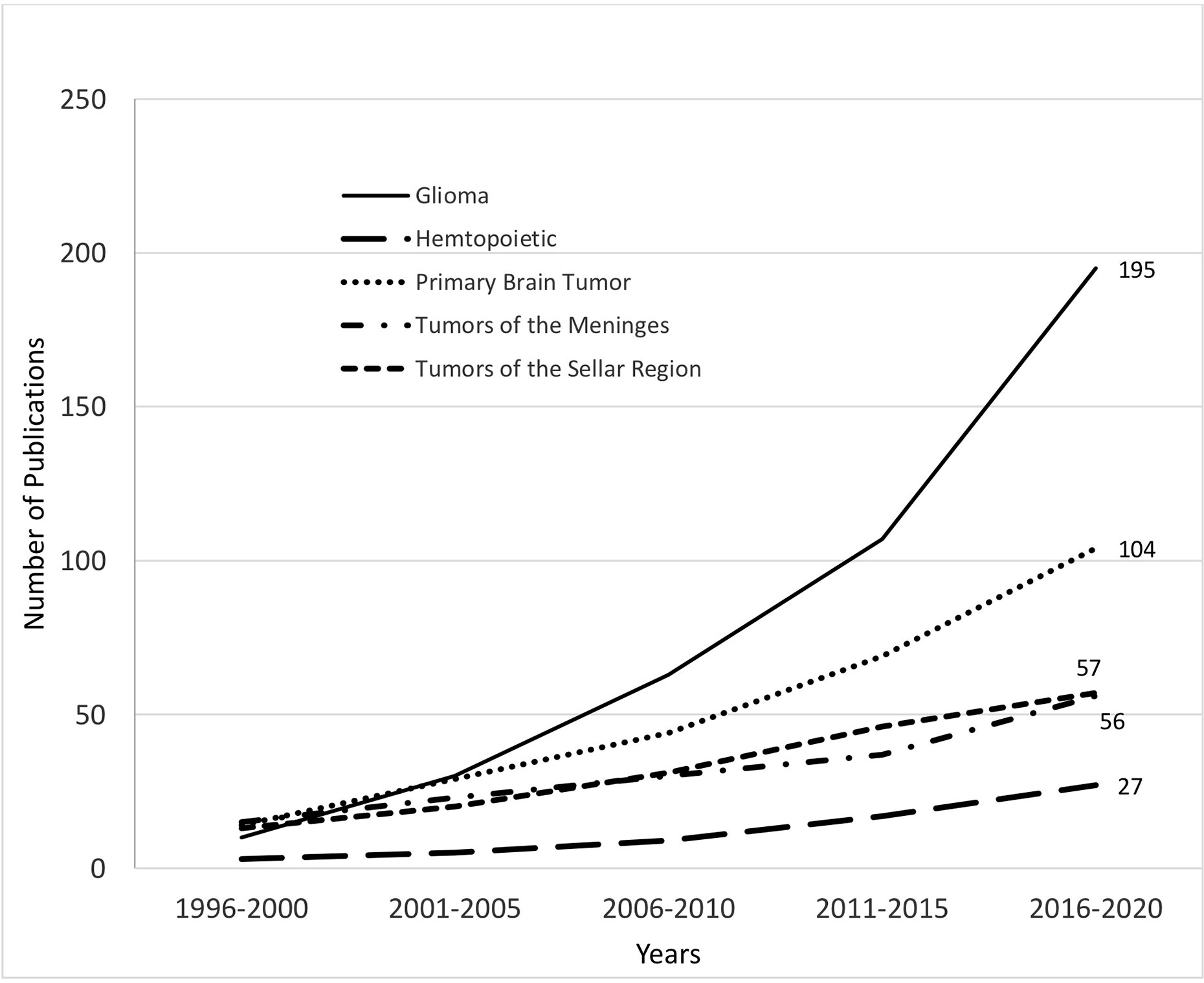
Figure 2 Published journal articles on top topics of primary CNS tumor from the SEA region during 1996 to 2020.
The age distribution of subjects involved in the included studies had the following demographics: adult population (n=337, 61.4%), pediatric age group (n=71, 12.9%), both adult and pediatric patients (n=6, 1.1%). Some articles did not specify age of population of interest (n=135, 24.6%).
Primary Brain Tumor Research Output: Top Journals and Southeast Asian Institutions
The top journals that published articles on primary CNS tumors from the SEA region were: Journal of the Medical Association of Thailand (n=61, 11.1%), The Medical Journal of Malaysia (n=27, 4.9%), Singapore Medical Journal (n=26, 4.7%), Journal of Clinical Neurosciences (n=21, 3.8%), Annals of the Academy of Medicine Singapore (n=19, 3.5%), and World Neurosurgery (n=15, 2.7%) (Table 1). One retrospective cohort study on medulloblastomas from Singapore was published in The Lancet Oncology, which had the highest IF (33.752) among all included articles (20). Five articles were published in discontinued journals. The authors affiliated with the following SEA institutions had the highest number of publications on primary brain neoplasms: National University of Singapore – Singapore (n=97 articles, 17.7%), Mahidol University – Thailand (n=58, 10.6%), National Neuroscience Institute, Tan Tock Seng Hospital – Singapore (n=57, 10.4%), Chulalongkorn University – Thailand (n=51, 9.3%), and Singapore General Hospital – Singapore (n=48, 8.7%). There were 77 institutions (public: 57, private: 20) from SEA that published on primary brain tumors. There are 25 institutions with existing Neurology residency programs and only 2 institutions offering a fellowship in neurooncology: one public institute in Singapore and one private hospital in the Philippines (Table 2).

Table 1 Journals where studies on primary central nervous system tumors from Southeast Asia were published (n=549).
Research Publication Bibliometric Indices
A total of 549 articles about primary CNS tumors were published from the SEA region: 246 (44.8%) from Singapore, 154 (28%) from Thailand, 113 (20.6%) from Malaysia, 15 (2.7%) from Indonesia, 12 (2.2%) from the Philippines, and 9 (1.6%) from Vietnam. Singapore, Thailand, and Malaysia published the most articles as well as had the highest values as reported in PlumX metrics (citations, usage, captures, mentions, and social media) and Scopus citations. No articles were identified from Brunei, Cambodia, Myanmar, and Timor-Leste (Table 3).
Southeast Asian Region Socioeconomic Determinants
The latest data from 2019 puts the total population size (in millions) of SEA at 661.91, roughly 9% of the world’s total population (4). Indonesia (n=270.6), Philippines (n=108.1), and Vietnam (n=96.5) had the largest population size, while Singapore (n=5.7), Timor-Leste (n=1.29), and Brunei (n=0.43) had the smallest population size.
In contrast, Singapore (USD 65,233.30), Brunei (USD 31,086.80), and Malaysia (USD 11,414.80) had the highest GDP per capita in SEA, while Timor-Leste (USD 1,294.20) had the lowest GDP per capita. Singapore (1.94%) and Malaysia (1.44%) contributed the most percentage of their GDP to R&D despite having only 100 and 120 neurologists, respectively. Thailand ranked third in terms of %GDP for R&D (1.0%) and number of neurologists (n= 645). Lastly, Cambodia, Lao, and Timor-Leste had the lowest GDP per capita, %GDP for R&D and number of neurologists (Table 4).
Burden of Disease of Primary Central Nervous System Neoplasm in Southeast Asian Nations
In 2016, the total incidence of primary brain tumors in SEA was 15,193 in absolute counts. Incidence and deaths showed similar trends (Table 5). Indonesia (n=6,337), Thailand (n=2,747), and the Philippines (n=2,297) had the highest incidence. The same countries recorded the most deaths: Indonesia (n=5,405), Thailand (n=2,490), and the Philippines (n=1,969). Timor-Leste and Brunei had the lowest incidence (Timor-Leste, n=31; Brunei, n=18) and deaths (Timor-Leste, n=18; Brunei, n=12). Lao and Timor-Leste had 100% mortality. In terms of DALYs, Indonesia (n=214,521), the Philippines (n=82,021), and Thailand (n=75,290) still ranked the highest. Singapore (n=2,392), Lao (n=5,481), and Timor-Leste (n=771) had the lowest DALYs (Table 5).
Association Analyses Between Socioeconomic Determinants and Burden of Disease Measures With Bibliometric Indices
Population, GDP per capita, %GDP for R&D, and total neurologists did not show any significant correlation with bibliometric indices at p value <0.05, except for a negative correlation with total neurologists and mentions (p value=0.024). The number of population per neurologist negatively correlated with all bibliometric indices. However, a significant correlation at p value <0.1 was noted between: a) population and mentions (p value=0.093); b) %GDP for R&D and total publications (p value=0.07); and c) total neurologist and total publications (p value=0.064) (Table 2).
The burden of disease measures showed a negative correlation with bibliometric indices at p value <0.05, specifically death with total publications (p=0.0362), mentions (p=0.0305), and social media (p=0.0408). Incidence also showed negative correlation with total publications (p=0.0424), mentions (p=0.0369), and social media (p=0.0468). PlumX indices [total publication (p=0.0341), citations (p=0.0356), usage (p=0.0449), captures (p=0.0414), mentions (p=0.0340), social media (p=0.0342)] and Scopus citations (p=0.0365)] were all negatively correlated with DALYs (Table 3).
Discussion
Published reports from SEA on primary CNS tumors from 1991 to 1995 were scarce and were mostly case reports on clinical experience (Figure 2), which may support epidemiologic data that CNS tumors are rare in comparison to other neoplasms especially in Asia (15, 22). From 2000 onwards, majority of the published articles focused on the diagnosis and treatment outcomes of GBMs. Though prognosis of brain cancer like GBM is dependent on histology and molecular biology, survival rates vary across continents even for the same tumor type and grade (6). Thus, there is a growing need for evidence-based medicine that takes into consideration geographical, ethnic, and sociocultural differences (3).
The top academic institutions from Singapore, Thailand, and Malaysia dominated the objective measurements of scientific research impact. This trend has been consistently reported for other neurologic diseases like epilepsy, dementia, and multiple sclerosis and neuromyelitis optica (21, 23, 24). The predisposition of these countries to perform well in terms of scientific research and development may be attributed to two reasons. First is their knowledge-based economies that give premium to technology and skill development, thus prioritizing scientific research output, in contrast to agricultural-based economies (23). Second is how developing nations generally lack healthcare systems, which have higher government subsidization and substantial public-private partnerships. This lessens the financial burden on patients, thus increasing access to otherwise costly diagnosis and treatment. When more patients are accurately diagnosed with CNS tumors and subsequently be started on treatment, then more data will be available for research purposes particularly on clinical outcomes (25, 26).
The published evidence regarding correlation of socioeconomic factors with research output about neurologic diseases show that the more developed countries measured by high GDP per capita and those countries that allocate a bigger percent of their GDP to R&D generally produce more research output that do well in terms of traditional and alternative bibliometrics (21, 23, 24). Our study presents a different trend in terms of brain tumor research from SEA countries. GDP per capita did not show any statistically significant correlation with bibliometric indices.
Spending on R&D may not be an appropriate metric in predicting improvement in research output for less common diseases like CNS tumors. We cite three explanations to support this hypothesis. First, primary CNS neoplasms are uncommon in a global scale as well as in the Asian population (3, 22). The fact that even high-income economies like Singapore, wherein molecular tests for diagnosis are available did not show an association of increasing R&D for CNS tumors may reflect the inherent difficulty to generate publications on brain tumors due to its rarity as a disease entity. Second, the diagnosis of primary brain tumors rely heavily on immunohistochemical and molecular tests, which are not readily accessible especially in low-income and developing countries. Theoretically, countries with higher GDP per capita dedicated to R&D should produce more research, however our results could be indicative that looking into the contribution of Total Health Expenditure to GDP could be a better measure for determining association with research output since diagnosis and treatment of brain cancer requires costly advanced methods. Lastly, life expectancy of malignant brain tumors, though improving, is still dismal allowing less time for adequate patient recruitment and selection for research. This discrepancy in terms of epidemiology and burden of disease becomes a hurdle for appropriate attention and funding for neurooncological diseases, which consequently could manifest as inadequacy in research performance from SEA countries.
In terms of socioeconomic determinants, only direct allocation in R&D had the biggest impact in increasing research productivity for primary brain tumors. This direct association of increased R&D spending with improved research output seen in both low and high-income SEA countries was also seen in multiple sclerosis, dementia, and movement disorders (21, 24, 27). This underscores the necessity for investment in research ventures dedicated to CNS neoplasms. The population of SEA countries did not show significant correlation with research output impact metrics. This was in concordance with correlational analyses of SEA studies for multiple sclerosis and dementia (21, 24). In addition, the number of neurologist seem to be negatively correlated to total publications and the number of times the studies get mentioned online. More neurologists did not seem to boost scientific research productivity in the field of CNS tumors.
Aside from increased direct spending on R&D, developing and strengthening human resources and access to care in neuro-oncology may translate to improved research outcomes. Possible strategies include increasing neuro-oncology fellowship opportunities in SEA, access to training programs in western countries, and soliciting additional government support through policymaking. The establishment of the Thai Brain Tumor Society in Thailand, enactment of National Integrated Cancer Control Act in the Philippines, and the Indian Society of Neuro-Oncology Annual Awards and Training Fellowships in Basic, Translational, and Clinical Neuro-Oncology could serve as a foundation for development of a regional collaborative brain tumor research network (8, 28, 29).
Interestingly, the burden of disease had a negative correlation research productivity. This mirrored trends in population size and GDP wherein higher populated countries with low GDP generally had lower research productivity. This trend of low GDP translating into low research output could possibly negatively impact future research ventures into topics on Neuro-oncology in SEA, which could potentially further neglect the unmet needs of these patients. Countries with bigger population and poorer economies would tend to have more cases of brain tumor patients with less access to quality healthcare, therefore resulting in higher mortality. These same countries allocate less of their GDP to R&D and subsequently fair worse in bibliometric indices.
The need to do research for the diagnosis, treatment, and quality of life of neurooncological patients increases as technological advances continue to prolong their survival. CNS cancer has increasing incidence and caused significant morbidity and mortality in the last global report for disease burden (1, 30). There have been previously published neurology-based bibliometric studies (31–37). These concentrated on analysis of highly cited articles, which inadvertently had a selection bias for studies published involving subjects and authors from western countries. Thus, published studies particularly focusing on the Asian population is lacking. To our knowledge, this is the first bibliometric analysis to address the knowledge gap in assessing research productivity output in SEA for primary CNS tumors.
Our study has several limitations. We only included peer-reviewed and published articles as these were readily accessible. Unpublished data from studies presented during proceedings in conferences and from the grey literature were not included, which may affect data on total publication. Another limitation was how search terms used may be too general that may miss specific terms pertaining to each tumor type. One important limitation of this study was to account for the foreseeable economic backlash (i.e. decrease in GDP) that worldwide measures for safety (i.e. quarantines, travel restrictions) will bring about due to the COVID-19 pandemic. The results of this study does not take into consideration the possible acute drop in GDP for SEA countries due to the COVID-19 pandemic. Further, the COVID-19 pandemic may also increase deaths as a metric, as cancer patients are immunocompromised and are a vulnerable population (38). Nevertheless, we employed an exhaustive and systematic search of literature from medical electronic databases.
Based on data presented, countries in the SEA have an increasing incidence of primary brain tumors that are causing significant burden of disease. However, financial and manpower resources to further advance research and development in this area of neurooncology seem to be inadequate based on limited scientific research productivity indices. More attention should be directed in this endeavor especially in recent events of how the COVID-19 pandemic has affected treatment of patients with brain tumors (39). The research performance of SEA countries can be improved by the following: a) increasing allocation of % GDP to research and development; b) strengthening the healthcare system with policies that push for greater government subsidy and increased public and private sector partnerships (26); and c) establishment and promotion of neurological training in residency and fellowship towards a career in neuro-oncology.
Conclusion
Research output from SEA on primary CNS tumors have been steadily increasing particularly regarding gliomas. Most articles are case reports on clinical experience. High quantity and quality studies came mostly from Singapore, Thailand, and Malaysia. Our study reaffirmed the direct positive correlation of greater percent allocation of GDP to research and development with better research productivity. The burden of disease and total neurologists inversely correlated with bibliometric indices of brain tumor publications. This highlights the importance of increasing public and private resources into producing high-grade publications in neuro-oncology to fill in the gap in the care of patients suffering from primary CNS neoplasms in SEA.
Data Availability Statement
The original contributions presented in the study are included in the article/supplementary materials; further inquiries can be directed to the corresponding author.
Author Contributions
MM, AE, and RJ onceptualized the study, contributed to the data curation, conducted a formal analysis, interpreted the data, wrote the original draft, and wrote, reviewed, and edited the manuscript. All authors contributed to the article and approved the submitted version.
Conflict of Interest
The authors declare that the research was conducted in the absence of any commercial or financial relationships that could be construed as a potential conflict of interest.
References
1. GBD 2016 Brain and Other CNS Cancer Collaborators. Global, regional, and national burden of brain and other CNS cancer, 1990–2016: a systematic analysis for the Global Burden of Disease Study 2016. Lancet Neurol (2019) 18:376–93. doi: 10.1016/S1474-4422(18)30468-X
2. Chien LN, Gittleman H, Ostrom QT, Hung KS, Sloan AE, Hsieh YC, et al. Comparative brain and central nervous system tumor incidence and survival between the United States and Taiwan based on population-based registry. Front Public Heal (2016) 4:151. doi: 10.3389/fpubh.2016.00151
3. Bray F, Ferlay J, Soerjomataram I. Global Cancer Statistics 2018: GLOBOCAN estimates of incidence and mortality worldwide for 36 cancers in 185 countries. CA Cancer J Clin (2018) 68:394–424. doi: 10.3322/caac.21492
4. World Economic Outlook Database, in: worldometers (2020). Available at: https://www.worldometers.info/world-population/#region (Accessed July 1, 2020).
5. OECD. Economic outlet for Southeast Asia, China, and India 2020: Rethinking education in the digital era. Paris: OECD Publishing (2019). doi: 10.1787/1ba6cde0-en
6. Gupta T, Achari R, Chatterjee A, Chen Z, Mehta M, Bouffet E, et al. Comparison of epidemiology and outcomes in Neuro-Oncology between the east and the west: challenges and opportunities. Clin Oncol (2019) 31:539–48. doi: 10.1016/j.clon.2019.05.018
8. Sathornsumetee S. Neuro-oncology: an emerging neurologic subspecialty in Thailand. Siriraj Med J (2011) 63:174–6.
9. Kurian KM, Jenkinson MD, Brennan PM, Grant R, Jefferies S, Rooney AG, et al. Brain tumor research in the United Kingdom: current perspective and future challenges. A strategy document from the NCRI brain tumor CSG. Neuro Oncol Pract (2018) 5:10–7. doi: 10.1093/nop/npx022
10. Kamath RS, Kamat RK, Pujar SM. Correlating R&D expenditure and scholarly publication output using K-means clustering. Int J Inf Technol Model Comput (2017) 5:01–7. doi: 10.5121/ijitmc.2017.5101
11. Lindsay JM. PlumX from Plum Analytics: not just altmetrics. J Electron Resour Med Libr (2016) 4065:8–17. doi: 10.1080/15424065.2016.1142836
12. Su C, Peng C, Agbodza E, Bai HX, Huang Y, Karakousis G, et al. Publication trend, resource utilization, and impact of the US National Cancer Database. Med (Baltimore) (2018) 97:1–7. doi: 10.1097/MD.0000000000009823
13. Akmal M, Hasnain N, Rehan A, Iqbal U, Hashmi S, Fatima K, et al. Glioblastome multiforme: a bibliometric analysis. World Neurosurg (2020) 136:270–82. doi: 10.1016/j.wneu.2020.01.027
14. Moher D, Liberati A, Tetzlaff J, Altman DG. Preferred Reporting Items for Systematic Reviews and Meta-Analyses: The PRISMA Statement. PLoS Med (2009) 6:e1000097. doi: 10.1371/journal.pmed.1000097
15. Butowski NA. Epidemiology and diagnosis of brain tumors. Continuum (N Y) (2011) 21:301–13. doi: 10.1212/01.CON.0000464171.50638.fa
16. National Heart, Lung and Brain website. Study quality assessment tools(2020). Available at: https://www.nhlbi.nih.gov/health-topics/study-quality-assessment-tools (Accessed November 6, 2020).
17. Web of Science Group. Journal Citation Reports: full journal list (2019). Available at: https://clarivate.com/webofsciencegroup/wp-content/uploads/sites/2/dlm/2019/08/JCR_Full_journal_list140619.pdf (Accessed November 6, 2020).
18. The World Bank. World Bank Open Data, in: worldbank.org (2020). Available at: https://data.worldbank.org/ (Accessed July 1, 2020).
19. Roxas A, Mehndiratta MM, Bornstein N, Macdonell R, Lim KS, Ng P, et al. The professional practice and training of neurology in the Asian and Oceanian Region: A cross-sectional survey by the Asian and Oceanian Association of Neurology (AOAN). J Neurol Sci (2017) 382:108–15. doi: 10.1016/j.jns.2017.09.022
20. Thompson EM, Hielscher T, Bouff E, Remke M, Luu B, Gururangan S, et al. Prognostic value of medulloblastoma extent of resection after accounting for molecular subgroup: a retrospective integrated clinical and molecular analysis. Lancet Oncol (2016) 17:1–12. doi: 10.1016/S1470-2045(15)00581-1
21. Sy MCC, Espiritu AI, Sy MSC, Jamora RDG, Anlacan VMM. Dementia research productivity and associations with socioeconomic factors and burden of disease in Southeast Asia. J Alzheimers Dis (2020) 76:1151–60. doi: 10.3233/JAD-200355
22. Sankaranarayanan R, Ramadas K, Qiao Y. Managing the changing burden of cancer in Asia. BMC Med (2014) 12:1–35. doi: 10.1186/1741-7015-12-3
23. Thuy Le MA, Sejahtera DP, Lim KS, Lai ST, Tan CT. Epilepsy research output in Southeast Asian countries: a systematic review. Neurol Asia (2019) 24:109–19.
24. Espiritu AI, Leochico CFD, Separa KJNJ, Jamora RDG. Scientific impact of multiple sclerosis and neuromyelitis optica spectrum disorder research from Southeast Asia: a bibliometric analysis. Mult Scler Relat Disord (2020) 38:101862. doi: 10.1016/j.msard.2019.101862
25. Chongsuvivatwong V, Phua KH, Yap MT, Pocock NS, Hashim JH, Chhem R, et al. Health and health-care systems in southeast Asia: diversity and transitions. Lancet (2011) 377:429–37. doi: 10.1016/S0140-6736(10)61507-3
26. Myint CW, Pavlova M, Thein KNN, Groot W. A systematic review of the health-financing mechanisms in the Association of Southeast Asian Nations countries and the People’s Republic of China: lessons for the move towards universal health coverage. PLoS One (2019) 14:e0217278. doi: 10.1371/journal.pone.0217278
27. Pajo AT, Espiritu AI, Jamora RDG. Scientific impact of movement disorders research from Southeast Asia: a bibliometric analysis. Park Relat Disord (2020) S1353-8020(20)30844-0. doi: 10.1016/j.parkreldis.2020.10.043
28. Republic of the Philippines. Official Gazette(2020). Available at: https://www.officialgazette.gov.ph/ (Accessed October 19, 2020).
29. Jalali R, Panda P. Indian Society of Neuro−Oncology: travails and triumphs. Int J Neurooncol (2018) 1:3.
30. De Robles P, Fiest KM, Frolkis AD, Pringsheim T, Atta C, St. Germaine-Smith C, et al. The worldwide incidence and prevalence of primary brain tumors: A systematic review and meta-analysis. Neuro Oncol (2015) 17:776–83. doi: 10.1093/neuonc/nou283
31. Care N, Ramos MB, Koterba E, Júnior JR, Teixeira MJ, Figueiredo EG. A bibliometric analysis of the most cited articles in neurocritical care research. Neurocrit Care (2019) 31:365–72. doi: 10.1007/s12028-019-00731-6
32. Samanci Y, Samanci B, Sahin E. Bibliometric analysis of the top-cited articles on idiopathic intracranial hypertension. Neurol India (2019) 67:78–84. doi: 10.4103/0028-3886.253969
33. Chen Y, Wang X. Bibliometric analysis of exercise and neuropathic pain research. J Pain Res (2020) 13:1533–45. doi: 10.2147/JPR.S258696
34. Lu VM, Kerezoudis P, Patel NP, Jones DT, Cutsforth-Gregory JK, Graff-Radford J, et al. Our efforts in understanding normal pressure hydrocephalus: learning from the 100 most cited articles by bibliometric analysis. World Neurosurg (2020) 137:429–34.e13. doi: 10.1016/j.wneu.2020.02.021
35. Mohammed MF, Marais O, Bhulani N, Ferguson D, Nicolaou S, Khosa F. The top 100 most-cited articles in stroke imaging: a bibliometric analysis. Curr Probl Diagn Radiol (2017) 47:161–7. doi: 10.1067/j.cpradiol.2017.06.003
36. Soo B, Hwan I, Min K. Top 100 cited articles on sleep medicine: a bibliometric analysis. Eur Neurol (2020) 83:111–20. doi: 10.1159/000507393
37. Popkirov S, Jungilligens J, Schlegel U, Wellmer J. Research on dissociative seizures: a bibliometric analysis and visualization of the scientific landscape. Epilepsy Behav (2018) 83:162–7. doi: 10.1016/j.yebeh.2018.03.041
38. Bakouny Z, Hawley JE, Choueiri TK, Peters S, Rini BI, Warner JL, et al. COVID-19 and cancer: current challenges and perspectives. Cancer Cell (2020) 20:1–67. doi: 10.1016/j.ccell.2020.09.018
Keywords: brain tumor, socioeconomic factors, burden of disease, bibliometric analysis, research productivity, Southeast Asia
Citation: Mondia MWL, Espiritu AI and Jamora RDG (2020) Primary Brain Tumor Research Productivity in Southeast Asia and Its Association With Socioeconomic Determinants and Burden of Disease. Front. Oncol. 10:607777. doi: 10.3389/fonc.2020.607777
Received: 18 September 2020; Accepted: 23 November 2020;
Published: 23 December 2020.
Edited by:
Katherine B. Peters, Duke University Medical Center, United StatesReviewed by:
Alissa A. Thomas, University of Vermont, United StatesKristin Schroeder, Duke Cancer Institute, United States
Copyright © 2020 Mondia, Espiritu and Jamora. This is an open-access article distributed under the terms of the Creative Commons Attribution License (CC BY). The use, distribution or reproduction in other forums is permitted, provided the original author(s) and the copyright owner(s) are credited and that the original publication in this journal is cited, in accordance with accepted academic practice. No use, distribution or reproduction is permitted which does not comply with these terms.
*Correspondence: Roland Dominic G. Jamora, cmdqYW1vcmFAdXAuZWR1LnBo; orcid.org/0000-0001-5317-7369
 Mark Willy L. Mondia
Mark Willy L. Mondia Adrian I. Espiritu
Adrian I. Espiritu Roland Dominic G. Jamora
Roland Dominic G. Jamora